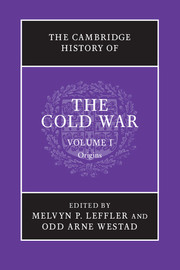Book contents
- Frontmatter
- 1 The Cold War and the international history of the twentieth century
- 2 Ideology and the origins of the Cold War, 1917–1962
- 3 The world economy and the Cold War in the middle of the twentieth century
- 4 The emergence of an American grand strategy, 1945–1952
- 5 The Soviet Union and the world, 1944–1953
- 6 Britain and the Cold War, 1945–1955
- 7 The division of Germany, 1945–1949
- 8 The Marshall Plan and the creation of the West
- 9 The Sovietization of Eastern Europe, 1944–1953
- 10 The Cold War in the Balkans, 1945–1956
- 11 The birth of the People’s Republic of China and the road to the Korean War
- 12 Japan, the United States, and the Cold War, 1945–1960
- 13 The Korean War
- 14 US national security policy from Eisenhower to Kennedy
- 15 Soviet foreign policy, 1953–1962
- 16 East Central Europe, 1953–1956
- 17 The Sino-Soviet alliance and the Cold War in Asia, 1954–1962
- 18 Nuclear weapons and the escalation of the Cold War, 1945–1962
- 19 Culture and the Cold War in Europe
- 20 Cold War mobilization and domestic politics: the United States
- 21 Cold War mobilisation and domestic politics: the Soviet Union
- 22 Decolonization, the global South, and the Cold War, 1919–1962
- 23 Oil, resources, and the Cold War, 1945–1962
- Bibliographical essay
- Index
- References
4 - The emergence of an American grand strategy, 1945–1952
Published online by Cambridge University Press: 28 September 2010
- Frontmatter
- 1 The Cold War and the international history of the twentieth century
- 2 Ideology and the origins of the Cold War, 1917–1962
- 3 The world economy and the Cold War in the middle of the twentieth century
- 4 The emergence of an American grand strategy, 1945–1952
- 5 The Soviet Union and the world, 1944–1953
- 6 Britain and the Cold War, 1945–1955
- 7 The division of Germany, 1945–1949
- 8 The Marshall Plan and the creation of the West
- 9 The Sovietization of Eastern Europe, 1944–1953
- 10 The Cold War in the Balkans, 1945–1956
- 11 The birth of the People’s Republic of China and the road to the Korean War
- 12 Japan, the United States, and the Cold War, 1945–1960
- 13 The Korean War
- 14 US national security policy from Eisenhower to Kennedy
- 15 Soviet foreign policy, 1953–1962
- 16 East Central Europe, 1953–1956
- 17 The Sino-Soviet alliance and the Cold War in Asia, 1954–1962
- 18 Nuclear weapons and the escalation of the Cold War, 1945–1962
- 19 Culture and the Cold War in Europe
- 20 Cold War mobilization and domestic politics: the United States
- 21 Cold War mobilisation and domestic politics: the Soviet Union
- 22 Decolonization, the global South, and the Cold War, 1919–1962
- 23 Oil, resources, and the Cold War, 1945–1962
- Bibliographical essay
- Index
- References
Summary
On April 12, 1945, President Franklin D. Roosevelt died. His vice president, Harry S. Truman, assumed the leadership of the United States of America. He had been in office only a few months, and knew little about his predecessor’s diplomacy and strategy. He felt “like the moon, the stars, and all the planets had fallen” on him. “Pray for me now,” he whispered to friendly reporters the next day.
Challenges and aspirations
Truman presided over the greatest military and economic power the world had ever known. War production had lifted the United States out of the Great Depression and had inaugurated an era of unimagined prosperity. Gross national product increased by 60 percent during the war, total earnings by 50 percent. Despite social unrest, labor agitation, racial conflict, and teenage vandalism, Americans had more discretionary income than ever before. Simultaneously, the US government had built up the greatest war machine in human history. By the end of 1942, the United States was producing more arms than all the Axis states combined, and, in 1943, it made almost three times more armaments than did the Soviet Union. In 1945, the United States had two-thirds of the world’s gold reserves, three-fourths of its invested capital, half of its shipping vessels, and half of its manufacturing capacity. Its GNP was three times that of the Soviet Union and more than five times that of Britain. It was also nearing completion of the atomic bomb, a technological and production feat of huge costs and proportions.
Yet Truman and his advisers did not feel secure. They feared that the United States would again sink into depression. They understood that wartime government demand had boosted production, and they wondered what would replace it at the war’s end. They were convinced that they needed an open world trading environment to sustain demand. High tariffs, quotas, and exchange restrictions had sundered the global trading system during the 1930s as had the trading blocs established by the Nazis, the Japanese, and even the British. Now, as the war approached an end, the appeal of national planning and statist controls to many people in Europe and Asia, coupled with the popularity of social-welfare programs, posed new challenges to the world’s foremost champion of free enterprise, private property, and individual rights.
- Type
- Chapter
- Information
- The Cambridge History of the Cold War , pp. 67 - 89Publisher: Cambridge University PressPrint publication year: 2010
References
- 8
- Cited by

